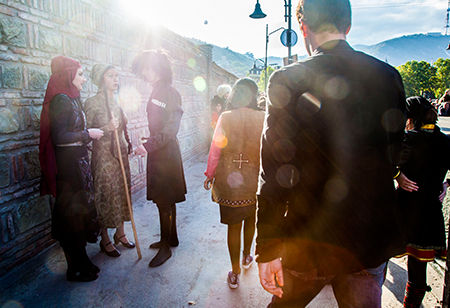Georgia reveals initial data from country’s first Census in 12 years

Preliminary data from the country’s first Census in 12 years has been released today.
The first pieces of information from the 2014 Georgian Census revealed the country’s population had decreased in the past 12 years’, more than 1 million people lived in capital Tbilisi, and now there were more women in Georgia than men.
The final results of the Census will be published in April 2016.
Today the National Statistics Office of Georgia, Geostat, released preliminary population data obtained in the 2014 Census.
The data revealed as of January 1, 2015, Georgia’s population reached 3,729,635. This was a 14.7 percent decrease since 2002 when the population was 4,371,535. The reason for this was believed to be high emigration rates in the past 12 years. Also in contrast to 2002, the recent survey was not conducted in Georgia’s breakaway regions Abkhazia and Tskhinvali (South Ossetia).
The surveying took place from November 5-19, 2014 across the country and included all people who spent one year or more living in Georgia, as of November 5, 2014.
In terms of population spread, the Geostat data showed more than half of everyone in Georgia (57.4 percent of the total population) lived in Georgia’s urban areas. This was a 5.1 percent increase on 2002 data. Similarly, 42.6 percent of the country’s population lived in rural villages.
However since the last Census in 2002, fewer people were now living in Georgia’s villages. Geostat said the village population had decreased by 23.8 percent and the number of people living in cities had decreased by 6.3 percent – but these findings were relative to the lower overall population numbers.
Tbilisi, Georgia’s capital city had the highest population density of the whole country. Geostat noted 30 percent of the population now lived in Tbilisi – a 5.2 percent increase on 2002 data.
In total, 1,118,035 people now lived in Tbilisi, which was 3.4 percent more than 12 years ago. One reason for this was because of the amalgamation of Mtskheta and Gardabani being regarded as a part of Tbilisi instead of separate areas.
A population boom was experienced in Georgia’s Black Sea city Batumi as well – the coastal city’s population increased by 26.3 percent in the past 12 years. The reason for this was the uniting of Khelvachauri municipality to Batumi.
The biggest population increase of Georgian cities was observed in Rustavi; 7.3 percent more people lived there today than in 2002. Today Rustavi has 124,908 residents.
In general, fewer people now lived in Georgia’s rural areas. The most significant decline in population was observed in the Racha-Lechkhumi and Lower Svaneti region (37.4 percent) followed by the Samegrelo-Upper Svaneti region (29 percent). The smallest population drop was experienced in the Adjara region (10.6 percent).
On another note, gender statistics comparing the 2002 and 2014 Census data revealed there were now more women in Georgia than men.
The preliminary Geostat data showed 47.7 percent of the population were men while 52.3 percent were women.
As for population data by age, the biggest increase in population size was recorded in the 50-59 age group, while the highest decline was experienced in the 10-19 age group for both genders.
The 2014 Census also recorded the level of agricultural activity in Georgia.
In 2014 there were 640,302 family farms registered in Georgia while in 2004, 10 years earlier, there were 728,247 registered family farms in Georgia. It should be taken into account that during the 2004 survey, the areas of Tbilisi, Kutaisi, Rustavi, Batumi and Poti were not surveyed.
Currently, the majority of family farms were in the Imereti region (19 percent), followed by Kakheti (14.3 percent), Samegrelo-Upper Svaneti (13 percent), Lower Kartli (11.4 percent), Shida Kartli (10 percent), Tbilisi (8.7 percent), Adjara (7.1 percent), Samtskhe-Javakheti (5.5 percent), Guria (5.1 percent), Mtskheta-Mtianeti (4.1 percent) and finally Racha-Lechkhumi and Lower Svaneti (1.9 percent).
In recent months GeoStat has begun reviewing and collating Census 2014 data obtained during field work in November 2014. Geostat was responsible for carrying out the survey, which saw about 12,300 employees go door-to-door and survey every citizen and foreign resident in Georgia.
Furthermore, residents in 382 villages in Georgia’s mountainous areas were surveyed in September 2014 as bad weather was forecast for November.
The Census determines the population size and how it is composed (gender, age), employment rate, level of education and health, a person’s livelihood and household conditions, agricultural activities and more.
 Tweet
Tweet  Share
Share